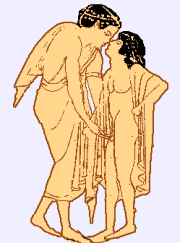|
性行为的基本类型
|
|
3.
同性性交
|
|
非指人而指行为
|
|
 |
|
娈童
古希腊人曾经把同性性行为接纳为一名男子的性活动中的正常部分,并把它视为有益于社会习俗的文明行为,称之为娈童(paiderastia,照字面意思为”男孩之爱“,
自pais:男孩或在这里更合适解释成:少年;和自eran:爱)。这种恋爱关系那时从来没有被视为婚姻和父权的障碍。(自古希腊花瓶画)
蒙柏林SPK斯泰特尔博物馆惠允
|
|
Paiderastia
The ancient Greeks accepted homosexual behavior as a normal part of a man's sexual activity and cultivated it as a socially beneficial custom called paiderastia (literally, love of boys, from pais: boy or rather here: male adolescent, and eran: to love). These love relationships were never seen as obstacles to marriage and fatherhood.(After an ancient Greek vase painting)Staatl. Museen zu Berlin, SPK |
|
|
金西同样经过验证后认为,即使作为整体的和同一的个体,异性-同性恋性倾向可以在经历一个时期之后发生改变。有的男人和女人,在其一生的一个时期的行为完全是异性恋的,而在另一个时期却完全是同性恋的。有的则参与双性性行为,但是,他们的异性与同性的性倾向程度变异较大。有一些人首先对两性有着相等的性爱兴趣,然后只是逐渐明显地偏爱一个性别或另一个性别。但是,这种性偏爱可能不一定持续不变。甚至于,随着时间的推移,一个人的性倾向的程度在金西的性行为等级量表上可能会数次发生改变。
如果把作为整体的人类分成“异性恋者”和“同性恋者”是错误的话,那么把任何一个特定的个体称作“异性恋”或“同性恋”恰恰也是错误的。出于同样的原因,不可能确定多少人是“异性恋”或多少人是“同性恋”。只有可能确定在任何设定的时间里,有多少人属于异性-同性性倾向等级量表上的哪一个类型。
诸如“那里有多少同性恋者?”或“我是同性恋者吗?”这样的提问,从科学意义上看,并没有答案。简而言之,同性性行为并不局限在极少数的“同性恋者”,而且程度不等地同样存在于许多没有用这种标签标称自己的其他个体之中。(想要了解这样的例子,请点击此处)
所以,以下的内容只是描述同性性行为的基本类型,并没有设定这种行为只是发生在特定的人之间。
|
|
Basic Types of Sexual Behavior |
|
3. Homosexual Intercourse |
|
Not Persons, but Behaviors |
|
Kinsey also recognized that even in one and the same individual the heterosexual-homosexual balance may shift over a period of time. There are men and women whose behavior is exclusively heterosexual at one time in their lives and exclusively homosexual at another time. Some engage in both types of behavior but with varying degrees of intensity. Others begin with an equal erotic interest in both sexes and only gradually develop a clear preference for one or the other. However, this preference may not always remain permanent. Indeed, a person's position on Kinsey's rating scale may change several times over the years. |
If it is wrong to divide the population as a whole into "heterosexuals" and "homosexuals", it is just as wrong to call any particular individual a "heterosexual" or a "homosexual". By the same token, it is impossible to determine how many people are "heterosexual" or "homosexual". It is only possible to determine how many people belong, at any given time, to each of the categories on a heterosexual-homosexual rating scale. Questions like "How many homosexuals are there?" or "Am I a homosexual?" do not have a scientifically meaningful answer.
In short, homosexual behavior is not restricted to a tiny minority of “homosexuals”, but is also found - to a greater or lesser extent - in many other individuals who do not fit this label. (For an example, click
here.)
Therefore, the following sections simply describe the basic forms of homosexual intercourse without presuming that it occurs only between particular persons. |